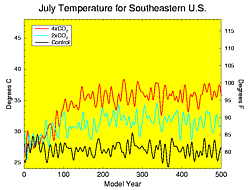Impact of CO2-induced Warming on Summertime Heat Index
The heat index (also called “apparent temperature”) is a measure of the stress imposed on humans by elevated levels of atmospheric moisture. These conditions inhibit the ability of the body to dissipate heat, thereby causing discomfort. Specifically, for a given atmospheric temperature and moisture content, the heat index is the temperature that the body would “feel” if the moisture content were reduced to a predetermined reference amount. For example, an air temperature of 95F with a relative humidity of 60 percent translates to an apparent temperature (heat index) of 110F, thereby denoting the equivalent temperature that the body would feel with the reference amount of moisture in the air.
Figure 1 shows time series of surface heat index values from three GFDL climate model experiments. The corresponding time series for surface air temperature are shown in Fig. 2. The black, blue, and red lines indicate results from the control, 2xCO2, and 4xCO2 experiments, respectively. The time series are plotted for a large region of the southern United States (79-97W, 31-40N). The differences between the control and enhanced CO2 heat index values in Fig. 1 result from increases in both air temperature and moisture content.
An important result emerging from these simulations is that the Southeastern U.S., as well as other tropical, subtropical, and middle-latitude regions with moist climates, could experience much higher summertime heat index levels in a future climate compared to the current climate. For example, under a CO2 quadrupling scenario, the model simulates an increase in summertime heat index values for the Southeastern U.S. of almost 25 degrees Fahrenheit.
It should be noted that temperatures predicted in the enhanced CO2 experiments can exceed the range for which the definition of a heat index is valid.
Overviews of other GFDL climate research can be found on our NOAA/GFDL home page.




